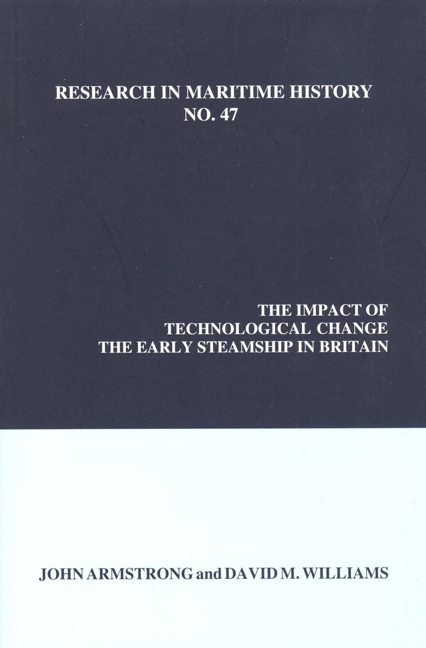Book contents
- Frontmatter
- Contents
- Series Editor's Foreword
- About the Authors
- Introduction
- Chapter 1 British Steam Navigation, 1812 to the 1850s: A Bibliographical and Historiographical Review
- Chapter 2 Some Official Listings of “Vessels Navigated by Steam” in Britain up to 1851: Evidence and Interpretation
- Chapter 3 The Steamboat, Safety and the State: Government Reaction to New Technology in a Period of Laissez-Faire
- Chapter 4 The Steamboat and Popular Tourism
- Chapter 5 The Thames and Recreation, 1815-1840
- Chapter 6 Steam Shipping and the Beginnings of Overseas Tourism: British Travel to North Western Europe, 1820-1850
- Chapter 7 Technological Advance and Innovation: The Diffusion of the Early Steamship in the United Kingdom, 1812-1834
- Chapter 8 The Steamship as an Agent of Modernisation, 1812-1840
- Chapter 9 “A New and Very Modern Business:” The Traffic and Operations of the Early Steamship
- Chapter 10 Promotion, Speculation and Their Outcome: The “Steamship Mania” of 1824-1825
- Chapter 11 The Perception and Understanding of New Technology: A Failed Attempt to Establish Transatlantic Steamship Liner Services, 1824-1828
- Chapter 12 The “Norwich Explosion” of 1817: A Local Tragedy of National Significance
- Chapter 13 Early Steamboat Services and Their Impact in North Wales, 1817-1840s
- Chapter 14 The Beginnings of a New Technology: The Constructors of Early Steamboats, 1812-1822
Chapter 8 - The Steamship as an Agent of Modernisation, 1812-1840
- Frontmatter
- Contents
- Series Editor's Foreword
- About the Authors
- Introduction
- Chapter 1 British Steam Navigation, 1812 to the 1850s: A Bibliographical and Historiographical Review
- Chapter 2 Some Official Listings of “Vessels Navigated by Steam” in Britain up to 1851: Evidence and Interpretation
- Chapter 3 The Steamboat, Safety and the State: Government Reaction to New Technology in a Period of Laissez-Faire
- Chapter 4 The Steamboat and Popular Tourism
- Chapter 5 The Thames and Recreation, 1815-1840
- Chapter 6 Steam Shipping and the Beginnings of Overseas Tourism: British Travel to North Western Europe, 1820-1850
- Chapter 7 Technological Advance and Innovation: The Diffusion of the Early Steamship in the United Kingdom, 1812-1834
- Chapter 8 The Steamship as an Agent of Modernisation, 1812-1840
- Chapter 9 “A New and Very Modern Business:” The Traffic and Operations of the Early Steamship
- Chapter 10 Promotion, Speculation and Their Outcome: The “Steamship Mania” of 1824-1825
- Chapter 11 The Perception and Understanding of New Technology: A Failed Attempt to Establish Transatlantic Steamship Liner Services, 1824-1828
- Chapter 12 The “Norwich Explosion” of 1817: A Local Tragedy of National Significance
- Chapter 13 Early Steamboat Services and Their Impact in North Wales, 1817-1840s
- Chapter 14 The Beginnings of a New Technology: The Constructors of Early Steamboats, 1812-1822
Summary
This article arises from our view that writers on industrialization and development have largely ignored the significance of the early steamship in the process of economic and social change before the mid-nineteenth century. If one examines studies of industrialization in Britain - the first industrial nation and the European pioneer of the steamship - the importance, and indeed even the coverage attributed to the early steamship is at best modest and in some instances scarcely more than a mention. Where the steamship does appear in general studies of the British experience it is often merely in the form of noting the first instance of steam navigation in 1812 and thereafter suggesting that “the steamship remained essentially a river boat until the middle years of the nineteenth century,” or was “limited to inland waters and narrow seas.” Not until the steamship began to operate in longer-distance oceanic trades after 1850 do general studies afford it any serious coverage and even then the emphasis is on the period following the opening of the Suez Canal in 1869 and the development of the triple-expansion engine.
Such interpretations to us fail to appreciate the significant impact of the early steamship. This study is set in the thirty years or so after the appearance of the first steamship in Europe to operate a commercial service in 1812. We argue that during this period the steamship was a pioneering vehicle of change in many of the aspects of attitudes, practice and organization that crucially distinguish a modern from a pre-modern economy. While analysis is focused on Britain, there are wider implications, for a unique feature of the innovation of the steamship was the speed and breadth, nationally and internationally, of its diffusion. Within a quarter-century of its invention, steamships were operating in dozens of countries and served every continent.
The importance of the steamship as an agent of modernization in the context of Britain stems from two factors. Both have to be considered in relation to the railway that is widely held to be the agent of the crucial breakthrough into the modern age, a view that serves to explain the neglect of the early steamship by so many writers. The first of these is that in Britain the steamship preceded the railway by almost twenty years, if the Liverpool to Manchester line is taken as the first genuine locomotive-operated railway.
- Type
- Chapter
- Information
- The Impact of Technological ChangeThe Early Steamship In Britain, pp. 165 - 182Publisher: Liverpool University PressPrint publication year: 2011



